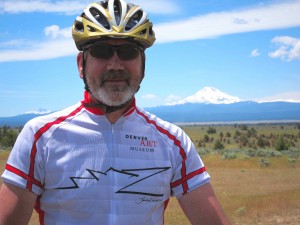The Biology of Bad Behavior

Rock climbing, biking, or violent crime?
My resting heart rate is 56 beats per minute. I’ve always interpreted that as a sign of good health. It may also mean that I’m a natural born killer.
That’s one of the conclusions that Adrian Raine might like you to draw from his new book, The Anatomy of Violence: The Biological Roots of Crime. Raine’s work is essentially a continuation of E.O. Wilson’s research on sociobiology. Wilson linked evolutionary and genetic influences to human behavior and, especially, to our reproductive habits, urges, and processes.
Raine takes sociobiology a step farther. If our genes can influence our reproductive behaviors, could they not also influence violent and criminal behavior? Are criminals different than non-criminals in some biological way? If so, can we use biology to predict who will commit crimes? Then what?
Let’s take low heart rate, for example. Raine reports evidence that a significant number (much higher than chance) of antisocial criminals have lower than average resting heart rates. Further, the condition points toward violent crime and not to other forms of behavior. It’s not only a predictor; it’s also a specific predictor.
Why would low heart rate point to violent crime? Raine offers three theories. First, there’s the fearlessness theory — “A low heart rate is thought to reflect a lack of fear.” Second is the low empathy theory – “Children with low heart rates are less empathic than children with high heart rates.” Third is the stimulation-seeking theory – low heart rate is associated with low arousal and “…those who display antisocial behavior seek stimulation to increase their arousal levels…”
I’m going with stimulation-seeking theory. Perhaps that’s why I took up rock climbing at the tender age of 18. I just needed some stimulation.
So, what might we have predicted about my behavior when I was, say, 15? It might have been this: “Travis has a low heart rate. Therefore, we can safely predict that he will either become a rock climber or a psychopathic serial killer.” Hmm… now what?
Let’s say I do commit a crime. Does my low heart rate absolve me of responsibility? Should a jury put me in jail or simply require that I take stimulants to boost my heart rate? Or should the government require me to take such stimulants before I commit a crime, just to be on the safe side?
It’s a debate we need to have and Raine begins to frame it up. Unfortunately, he’s rather sloppy. For instance, he seems to make a fundamental error in explaining correlation and variability.
Raine, with fellow researcher Laura Baker, studied whether violent behavior can be inherited. They used “sophisticated statistical techniques” (multivariate analysis) to estimate the heritability of such behavior. Raine writes that he and Baker found, “Heritabilities that ranged from .40 to .50. That means that 40 to 50 percent of the variability among us in antisocial behavior is explained by genetics.”
Multivariate analysis, however, sorts out correlations, not variability. The degree of variability is not the correlation itself but rather the square of the correlation. With a correlation of .40, for instance, the square is .16. If X and Y have a correlation of .40, then 16% of the variability in Y is explained by X. Thus, Raine and Baker can explain between 16% and 25% of the variability in antisocial behavior through inheritance. That’s an important finding but not nearly as strong as Raine claims. It’s a fundamental mistake and weakens the argument considerably.
Elsewhere, Raine writes that Ted Bundy killed approximately 35 women. A few pages later, Bundy’s victims total more than 100. Raine informs us that his wife, sister, and cousin are all nurses. Therefore, he picks a nurse, “Jolly” Jane Topppan, to illustrate the “breakdown in the moral brain”. I don’t understand why Jolly Jane illustrates such a breakdown better than, say, Ted Kaczynski, the Unabomber (who, by the way, has a resting heart beat of 54).
I find this irksome because I generally agree with Raine’s claims. Biology does influence our behavior. Through poor editing and sloppy statistics, however, he undermines his own argument. Raine’s book is a good start but I hope a stronger, more tightly reasoned book comes along soon. In the meantime, I need some stimulation. I think I’ll take up nude skydiving.
Travis:
Now we know why employees were terminated and how.
You took them rock climbing and said you would make sure the ropes were safe….
Wasn’t it enough to be a high flying executive?
For shame.
How are you by the way?
I like your analysis.
Cheers
Dick Ott
You ask what cats can teach us. Either that even the stupid can survive, or that cunning trumps intelligence.